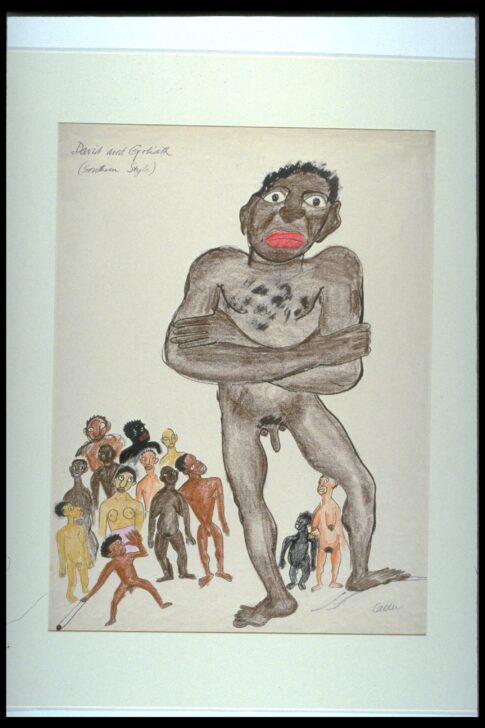David and Goliath (Southern Style)
Alexander Calder

Description
The artist Alexander Calder is renowned for his mobiles—abstract sculptures comprised of various shapes and colors and often suspended from high ceilings to mimic the kinetic effect of a baby mobile dangling over an infant’s crib. Lesser known are Calder’s works on paper, which have been overshadowed by his sculptural portfolio. In 1948 the University of Michigan Museum of Art (UMMA) acquired 7 of Calder’s early drawings in hopes of trading them for a more desirable Cezanne painting—a hope unrealized. These sketchy and figurative drawings composed with crayon and paper are world’s away from the geometrical and sculptural forms we associate with the artist. Considered as an entire group, these drawings are both puzzling and offensive to the contemporary observer.
David and Goliath (Southern Style), for example, recycles the biblical battle between giant and underdog, only to adorn it with racialized caricature. Eyes are drawn first to the giant Goliath’s grotesque facial features, exposed genitals, and minstrel-like red lips. Below, David (wielding a sword) and the group of figures behind him also reflect the artist’s lazy primitivism. These are not individuals, but a collection of cartoons comprised of saturated colors and distorted shapes, exaggerated facial features and genitalia. The catalog accompanying a 1972 exhibition of Calder’s early work, deemed David and Goliath exemplary of his early “experiment with social satire” (4). But David and Goliath (Southern Style) is not a social satire. It is rather an example of Calder’s unremarkable racism, to undoubtedly be found among the majority of his contemporaries. Calder’s drawing belongs to a vast visual culture of racism undergirding not only Alexander Calder’s body of artwork, but the entire corpus of modern art.
Usage Rights:
If you are interested in using an image for a publication, please visit https://umma.umich.edu/request-image/ for more information and to fill out the online Image Rights and Reproductions Request Form.